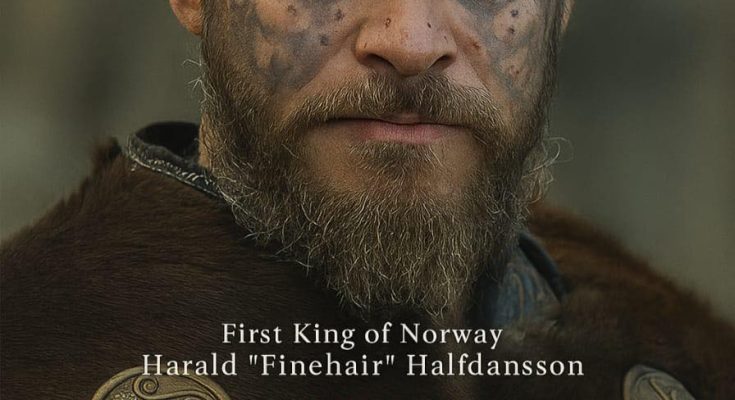Harald “Finehair” Halfdansson stands among the towering figures of early Scandinavian history, remembered as the man who forged Norway into a single kingdom. His story is one steeped in ambition, romance, warfare, and the kind of mythic qualities that blend history with legend. For centuries, skalds and chroniclers have recounted his rise from a regional chieftain to the first king of a united Norway, a feat that not only reshaped the political landscape of the Viking Age but also inspired generations of Norsemen who came after him. His legacy is not simply the tale of conquests but also of a visionary leader whose determination altered the destiny of a land once fractured into countless petty kingdoms. The release of his legendary tale now reignites fascination with this remarkable man, and the narrative unfolds like a saga that belongs as much to myth as to history.
The origins of Harald’s legend begin in the ninth century, when Norway was a patchwork of small chiefdoms, each ruled by jarls and petty kings. Power was fragmented, alliances fragile, and feuds commonplace. Into this turbulent world was born Harald, son of Halfdan the Black, a king whose dominion stretched across parts of eastern Norway. Halfdan was a capable ruler, ambitious in his own right, and his sudden death left young Harald to inherit his territories. Though still a boy, Harald’s destiny was already foreshadowed, for the sagas describe him as handsome, tall, and full of strength—a born leader who carried the aura of greatness. He was not content with ruling just a slice of Norway. His gaze was fixed on something greater: uniting the entire realm under his crown.
Central to Harald’s saga is a love story that has echoed across centuries. According to the sagas, he became infatuated with a woman named Gyda, the daughter of a powerful chieftain. When he sought her hand in marriage, she scornfully rejected him, saying she would only consent to wed a man who ruled all of Norway. Rather than take offense or turn his back, Harald embraced her challenge as destiny. He swore a vow not to cut or comb his hair until he had accomplished the unthinkable—bringing the scattered kingdoms of Norway beneath his rule. This vow would earn him the nickname “Finehair,” for when the task was finally complete, he had his long locks groomed, and the beauty of his hair became legendary. Thus began one of the most extraordinary quests in Viking history, fueled by love, ambition, and an unshakable will.
Harald’s campaign to unite Norway was long and arduous. The land was not easily conquered, for the petty kings valued their independence and resisted fiercely. Battles raged across fjords, valleys, and coastlines, with warriors clashing in longships and on blood-soaked fields. One of the most decisive confrontations was the Battle of Hafrsfjord, where Harald’s forces clashed with a coalition of rival chieftains who sought to halt his rise. The battle, as described in sagas and medieval sources, was fierce and bloody, with ships grappling, spears flying, and swords striking under the roar of war cries. When the dust settled, Harald emerged victorious, breaking the resistance of his most powerful enemies and securing his claim as the first true king of Norway. Hafrsfjord has since entered the annals of history as the defining moment of Harald’s reign, the battle that cemented his place as the unifier of the realm.
Yet conquest alone could not maintain a kingdom. Harald had to transform a land long accustomed to independence into a united entity under his authority. This required not only strength but also diplomacy and vision. He consolidated power by placing loyal jarls and kin to govern regions on his behalf, demanding oaths of fealty and tribute. Those who resisted were crushed or exiled, many of them fleeing west to settle in Iceland, the Faroe Islands, and beyond. In this way, Harald’s unification indirectly spurred the great wave of Norse expansion that carried Vikings across the seas. While some cursed him for driving them from their ancestral lands, others hailed him as a king of destiny who brought order to chaos.
The image of Harald “Finehair” is one wrapped in layers of myth and embellishment. Medieval historians such as Snorri Sturluson, writing centuries later in works like Heimskringla, depicted Harald as larger than life, a hero whose vow to win Gyda’s hand symbolized the unification of Norway itself. Whether Gyda truly spoke those fateful words or whether the saga-writers embellished the story to give Harald’s conquest a romantic allure may never be known. What remains clear, however, is that Harald was remembered as a man whose ambition reached beyond the ordinary. His refusal to accept a divided Norway set him apart from his contemporaries, and the mythic aura that surrounds him is testament to the impact his deeds had on the collective imagination of the Norse people.
Life as king was not without its challenges. Ruling over a newly forged kingdom meant constant vigilance. Dissent simmered, old rivalries lingered, and the authority of the crown was tested. Harald fathered many children—sources speak of as many as twenty sons—each with ambitions of their own. This abundance of heirs would later sow seeds of division, for succession disputes plagued Norway after Harald’s time. Yet even these struggles only highlight the magnitude of what Harald achieved. To build a kingdom from so many disparate pieces was no small feat; to hold it together required a strength of character few possessed.
Beyond politics and war, Harald’s reign marked a turning point in Norway’s cultural identity. He laid the foundation for a centralized monarchy, a concept foreign to a land used to independence. His rule also coincided with the era of Viking expansion, when Norsemen voyaged across Europe, raiding, trading, and settling in lands from Ireland to Russia. Harald’s consolidation of Norway gave these ventures a stronger base, ensuring that the Norse presence abroad was not merely the work of isolated bands but part of a broader cultural surge. In this sense, Harald was not only the king of Norway but also a figure who influenced the course of Viking history on an international scale.
Legends also paint Harald as a man of charisma and presence. His nickname, “Finehair,” may seem superficial, but in the poetic world of the Norse, it carried deep symbolism. Hair was often associated with honor, power, and virility, and Harald’s vow not to cut or comb his hair until he achieved greatness became a metaphor for his determination. When he finally had his locks groomed after uniting Norway, the beauty of his hair was said to shine like gold, reflecting the glory of his accomplishment. This imagery resonates even today, showing how physical appearance, legend, and destiny intertwined in the making of a king.
The later years of Harald’s life were marked by a gradual passing of authority to his sons. Though he had achieved greatness, time inevitably caught up with him, and he eventually relinquished much of his power to his son Eirik Bloodaxe, one of the most infamous of his heirs. Harald is believed to have lived to an old age, remarkable for a man of his era, and his memory endured long after his passing. His dynasty, known as the Fairhair dynasty, would shape Norwegian history for generations, even as internal strife and external pressures tested its endurance.
Today, the tale of Harald “Finehair” Halfdansson is not only a story preserved in medieval manuscripts but also one that continues to captivate modern audiences. His saga embodies universal themes: the power of love to inspire greatness, the unyielding drive to achieve the impossible, and the transformation of a land through sheer will. Whether viewed as a historical monarch or a legendary hero, Harald represents the archetype of the Viking Age ruler, embodying both its ferocity and its vision. Statues, sagas, and even popular culture continue to keep his memory alive, ensuring that his place as the first king of Norway is never forgotten.
What makes Harald’s tale so enduring is the blend of human emotion and monumental achievement at its heart. His pursuit of Gyda’s love gives his conquest a deeply personal motivation, transforming what might have been seen as mere ambition into a quest infused with romance and destiny. His vow, his battles, and his triumphs elevate him to the realm of myth, where kings are not just rulers but symbols of unity and strength. The fact that his story has survived more than a thousand years speaks to its timeless resonance.
As we reflect on Harald’s legacy, we see not only a man but also the birth of a nation. Before him, Norway was fragmented, vulnerable, and divided. After him, it had an identity, a monarchy, and a future. That transformation, achieved through determination and vision, remains one of the defining moments in Scandinavian history. Harald “Finehair” Halfdansson thus stands as both a historical figure and a legendary icon, his tale a reminder that greatness often emerges from the boldness to pursue what others deem impossible. In uniting Norway, he did not merely win a kingdom; he created a legacy that endures in saga and memory, ensuring that his name will forever be spoken as the first king of Norway.



